 |
 |
 |
||||||||||||||||||||||||||||||||
- Abydos - Sanctuary of Osiris: the silence of the sands
[<< Previous report on expedition "Egypt-2013: Abydos, Sanctuary of Osiris ] [<< Chapter III of the report on expedition "Egypt - 2018: The Temple of Ramesses II " ] (Continuation) "She drove thine enemies away, she averted seasons [of calamity], she recited formulae with the magical power of her mouth, [being] skilled of tongue and never halting for a word, being perfect in command and word. Isis the magician avenged her brother. She went about seeking him untiringly. She flew round and round over the earth uttering walling cries of grief, and she did not alight on the ground until she had found him. She made light [to appear] from her feathers, she made air to come into being by means of her two wings, and she cried out the death cries for her brother. She made to rise up the helpless members of him whose heart was at rest, she drew from him his essence, and she made therefrom an heir." Pyramids Texts. Hymn to Osiris.
"It is impossible to state when and where the first shrines in honour of Osiris were built in Egypt, but it is tolerably certain that his most ancient shrine in the South was at Abydos, and his most ancient shrine in the North at Busiris, and that the cult of the god was firmly established in these places at the beginning of, if not before, the Dynastic Period. Abydos was, moreover, quite near to Netat, or Netit, the town on the Nile, or great canal of the district, near which Osiris was murdered by Set, and it was more natural for Isis when she found her husband's dead body there to take it to Abydos than to some more remote town. " Wallis Budge, Whether Abydos was just a place of the final rest of one of the most Ancient Egyptian Rulers, or was it a flourishing city with a well-developed infrastructure, the administrative center of the founders of the Great Egyptian Civilization, which later became the World's oldest Sacred Necropolis... The time leaves us only the tops of the icebergs, carrying the echoes of the last events, on which it once stops, "waiting for a certain interval" before the beginning of a new round of History - either a breakthrough or fading. This very time interval - the "period of silence" over the duration of which many ancient knowledge, skills and technologies were lost, carried away the direct answers to our numerous questions. So now, the attempts to solve these questions are existing only in the form of hypotheses with varying degrees of probability. But as long as we are following these interests and our need to search for the answers to these questions do not melt away, our distant Past is not so far away from us, and we, from the perspective of today, just need to find the right approach to its understanding. Abydos has always been one of the largest and most fertile Nomes of the Upper Egypt. Sohag Governorate (where the Nomes were located) is one of the leading producers of agricultural products in Egypt up to the present time. How far the ancient city of Abydos, located at the very edge of cultivation, was spreaded in its past is unknown. The part of its ruins that has survived appears to us only in the form of necropolises of the Early Dynasties, located on a barren plain, the so-called "Low Desert", stretching beyond the flood area of the Nile, being enclosed in a large desert "bay", surrounded by the steep limestone cliffs.
Here, on the edge of the Abydos desert, there is a large-scale ancient architectural complex, which history is dating back to the Pre-Dynastic times. This complex is dedicated to Osiris - a man whose deeds, according to the Pyramid Texts, served as a powerful impact to the formation and development of the Great Egyptian Civilization. "Osiris and Isis govern the whole world, and they foster and protect everything in it, and they divide the year into three parts, spring, summer, and winter. He abolished cannibalism, which was common in Egypt, he taught the people to plough and to sow, and to raise crops of
wheat and barley, and Isis showed them how to make
bread, and was the first to make them acquainted with the use to which wheat and barley could be put. Osiris was greatly devoted to agriculture. He was the first to drink wine, and he taught men to plant the vine, and how to make and preserve wine. Wallis Budge,
Abydos. The Northern Desert. Archaeological area of Kom-el-Sultan village.
4000 years ago «Egypt fights in the necropolis by hacking up the graves. I did the same, and the same happened as was done to one who transgresses the way of God.». King Kheti (2120-2070 до н.э.) Abydos passed into the hands of the Thebans, headed by Nomarch of Thebes - Antef II, who subsequently has established peace with Kheti. Large-scale restoration works started ... 4000-2400 years ago During the XI Dynasty, Antef V began to restore the Temple complex of Osiris for the first time. During the XII Dynasty, many monuments were added by Senusert I. During the Xlll Dynasty, Sebekhotep III has added the black granite gates, and during the XVIIIth Dynasty Thutmose III built a massive enclosure wall of about 6 meters width with a huge red granite Pylon that unfortunately did not survive till our time. Time passed and the most of the wall collapsed. The local settlements gradually expanded into the so-called "Territory of Osiris." A little later, probably at the time of the XX Dynasty, the wall was rebuilt, including in it's perimeter the remains of the late city buildings. During the XXVI - XXX Dynasty, the Temple complex was rebuilt and enlarged several times. Where exactly was the foundation of the original building, laid down in the immemorial times is still unknown. "The Northern Temple, with its powerful enclosure walls and a lake, is located in the middle of the Necropolis, the number of which tombs is increasing as they approach these walls. Auguste Mariette
"The western side of the outer perimeter of the wall is full of burials, located along its entire length. The number and quality of these burials increases as we approach the King's Hill (Kom-el-Sultan). On the western side of the complex, where the entrance is located, there are the ruins of a small Temple, built of limestone blocks (the rest - built of mudbricks). This is the Temple of Ramses II. Auguste Mariette Despite the high degree of destruction, some outlines and ownership of the buildings, located within the perimeter of the Enclosure Wall were determined and mapped by archeological mission of Auguste Mariette.
"... Perhaps the entrance to the Tomb was in one of the rooms of the Temple, and the Tomb itself was made in the Saiss style. Perhaps it was located in the foundation of the building, in underground crypts like in Dendera. Or maybe it was cut inside the rock like the Tomb of Apis in the Serapeum. But here (in Abydos) there is confusion and mix everywhere. The hands that destroyed the Temple certainly has damaged both its foundation and the Tomb of Osiris, if we assume that it existed here. We need to look under the foundation. Our search for the Tomb in the rock brought a negative result ... We know the conditions under which the Egyptian necropolises were made. All of them were located on the edge of the desert, where a thick layer of sand lying directly on a solid rock, stretching to the unknown depths. Burial Chambers, designed for mummies were carved in a rocky basement. In Abydos, everything is not like that. The sand here does not lie directly on the rocky foundation. Between the rock and the sand layer - here lies a poorly aggregated layer of molasse of 3-4 meters thickness. Egyptians never built any underground structures in it." Auguste Mariette, 1880 ... Does all this mean that there is no any reason to continue searches of the Tomb of Osiris, or any other serious underground structures in the studied area of Abydos? Or maybe the subterranean geological structures of Abydos still store a certain man-made architectural structures about the technology of creation and purposes of which we have no any idea at the moment? Year 1902 "The excavation of the temenos area was a difficult matter to arrange. On every side it was bounded so that no clear space could lie begun upon; and I was obliged to start by throwing back along a line of existing ruins. In the higher part of the ground, nearer to the desert, the clean sand surface of the old desert was found beneath all the towns piled one over the other. But this clean sand was inaccessible beneath the water in every part of the temple ground bounded by the great wall of Tahutmes III." Flinders Petrie, Year 1967 "Within our present concession the southwest part of the cemetery has been excavated but not exhaustively, while the northeast part of the cemetery has not been touched since Mariette’s day. Apart from one area intensively excavated by Petrie and some superficial excavations by Mariette, the interior of the “Osiris Temple Enclosure” remains unexcavated, while the northwest part of our concession has received little previous examination." David O`Connor The photo below, taken during the archaeological mission of David O'Connor in 1967, shows the territory inside the Enclosure Wall, excavated by Flinders Petrie. Fragments of buildings can hardly be guessed against the background of local surface relief. In the foreground - there is a lake, which water level varies depending on the Nile phase. In the upper right corner - there is a small hill (the so-called King's Hill or Kom-el-Sultan) with the ruins of buildings, dated by the Old and Middle Kingdom. Year 2018 For the convenience of understanding the described territory, lets take a look on a general photo of it: April 2018. When the Nile was in its low phase, this area looked like this:
Year 1967 "This season the Expedition concentrated on the comparatively simple task of beginning the clearance of a structure known as the “Portal of Ramesses II.” The so-called “Portal” is one of the minor mysteries of Abydos; only its exposed, four-columned portico has ever been examined in detail." David O`Connor, The picture below shows a four columned portico of the Temple of Ramses II before the excavations, undertaken by the Australian Egyptologist David O'Connor. In the background is the Coptic Monastery of St. Damiana, which history goes back in centuries. The ruins of the Temple-Portal of Ramses II after the excavation of 1967: Below (to the left) is a general plan of excavations in the northern part of the Abydos Desert, undertaken by the Pennsylvania-Yale archeological mission, directed by David O'Connor. To the right - a detailed plan of the cleared Temple area. In the first picture, the Temple of Ramesses II is marked (2). It is located directly in front of the entrance to the Territory of Osiris, enclosed by the Temenos wall of 6 meters width.
By the end of the archaeological work it was established that the Temple-Portal ruins are representing the remains of a building, not the ceremonial gates before the entrance into the "Territory of Osiris".
To the southwest of the portico, the archeological mission of O`Connor has discovered the ruins of an open courtyard with the remnants of a platform with the pedestals of the statues of Osiris (their feet are seen on the picture below).
In the same place, O'Connor's mission has found the fragments of a limestone Royal statue:
Studying the construction techniques of the ancient structure, basing only on the small remains of it, David O'Connor wrote in his report: "Although we do not yet have enough of the plan to make a detailed comparison with other New Kingdom temples our temple seems to be of an unusual type, designed perhaps for a special cult practice." Year 2018 The ISIDA Project research team has visited the northern part of Abydos in April 2018, 5 years after the previous expedition. The aim was still the same - to explore the ruins of an ancient non-standard complex and to try to understand the logic of ancient engineers and builders, who throughout all the Royal Dynasties have carefully supported something hidden under the sands of Abydos, conditionally called "The Tomb of Osiris" at all known times. 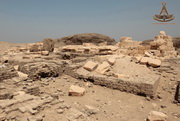 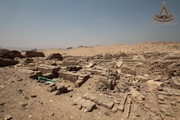 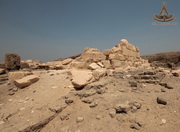 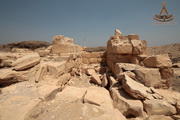  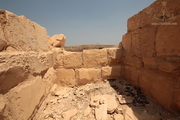 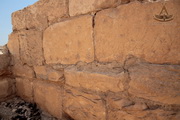 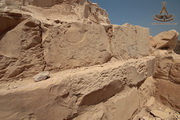  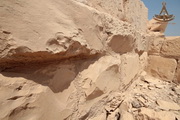 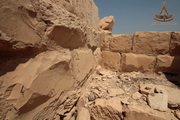 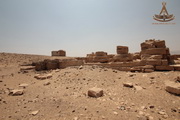 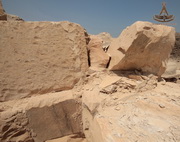 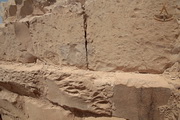 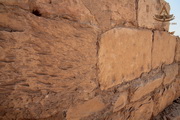  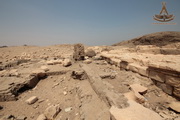  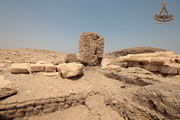 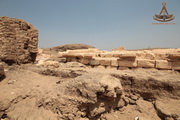 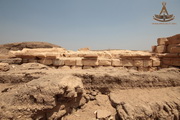 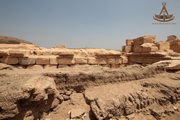 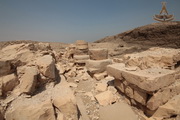 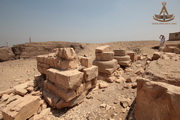  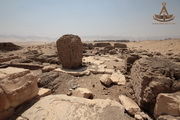 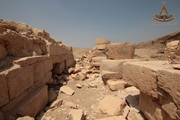 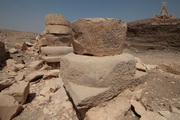 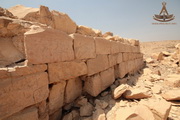 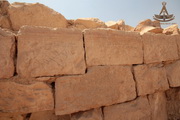 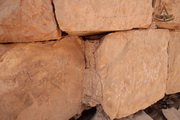 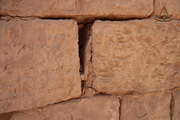  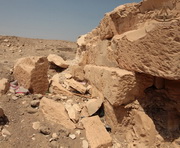 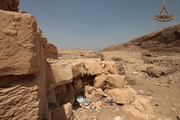 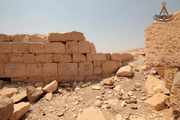 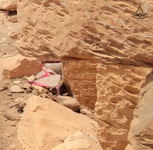 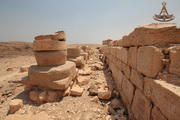 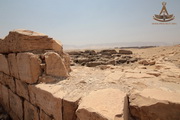 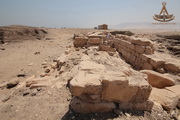 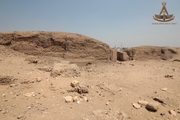 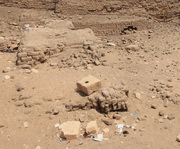 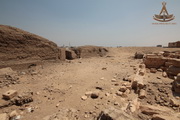 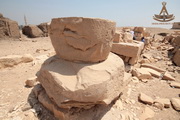 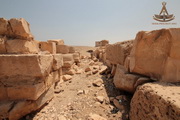 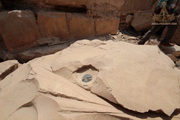  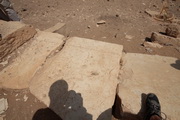  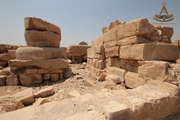 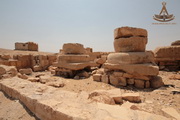 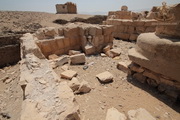  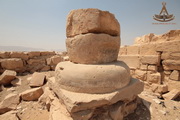 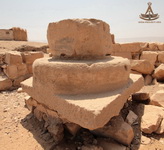 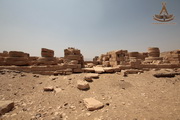 Let's pay attention to the rather familiar architectural element, reminding the outer border of the roof, now located almost at the level of the ground. Is it really an element of the roof design and we see only the top of the building? Or is it something else? But what? Below are some examples of similar elements of design:
There are much more examples of it, because it is a common architectural element of the Ancient Egyptian buildings, but all of them show that such an architectural solution is inherent to the top of the structures, not for their foundation in any way.
In our case, the ornament is totally absent. Can we make a conclusion, that we see only the top of a structure with some buildings of the later Dynasties, added to it's roof? Certainly, we can not make any final conclusions on this stage of studying, but even a flimsy hypothesis can fully claim on its verification. To make any solid conculsion - the archaeological excavations down the foundation of the building must be done. So, at the moment the question of the architectural designation of this element remains open. However, it should be noted that the construction of houses on the top of the fundamental ancient buildings, buried in the sand, was widely practiced in Egypt. The picture below demonstrates there are ruins of a small settlement, comfortably arranged on the roof of the Dendera Temple. The drawing was made during Napoleon Bonaparte's expedition to Egypt.
Pictures below are demonstrating the mudbrick structures, towering above the limestone blocks of the Temple-Portal ... Among the great number of fragments, scattered all over the territory of the Temple of Ramesses II, there is a small piece of a wall rib with a "roll". It indicates that a certain building had a certain height and a characteristic angle of the slope of the walls.
Perhaps, the reader will ask the question: "But what about the four-columned portico? The presence of the columns mean the existance of the floor / pavement / solid foundation under them!"
And the question will disappear, arising the new one: "Where did these columns come from and when? But such a study is beyond the frames of this brief report. * * * Considering the ancient structures, found on the territory of Abydos, we decided to study all of them as one complex (Osirion - Temple of Seti I - Temple of Ramses II - Sanctuary of Osiris). After all, the first buildings on the very dawn of Abydos, could not appear independant from each other in spite of the town planning logic. The late constructions grew one upon another, the facts were gradually covered with legends, the inexplicable things were interpreted by religions. ... Without changing the direction, according the sides of the World, lets pay attention to the outlines of the Temple-Portal of Ramses II and Osirion from the heigh of 485 meters.
Lets trace the contours of the boundaries of the ruins of the Temple-Portal of Ramses II and, without changing the dimension, apply them to Osirion:
Does this coincidence accidental? Everything is possible...
Что касается второго случая - объяснение то же самое. Мы опять имеем дело с подземной, невидимой со спутника камерой Осириона, вход в которую обозначен стрелкой и синим прямоугольником на схеме Навилля: As for the second case, the explanation is the same. Again we have deal with the underground, invisible from the satellite chamber of Osirion, the entrance to which is indicated by an arrow on the photo and a blue rectangle on the Naville's scheme:
A curious coincidence of the outlines of both buildings pushes a stream of thoughts, that already can not be stopped. "...Tourists visiting Abydos, after having crossed the temple of Seti, will find themselves before the majestic ruins of one of the most ancient edifices that the soil of Egypt has preserved for us and which was absolutely unknown up to these last few days. This indicates that this privileged land perhaps still contains under a thick bed of sand some great moniunents of whose existence no one had any idea." Edouard Naville, 1914 "Geographically, it was not especially well favored. All the politically and economically important towns of Upper Egypt stood close to the Nile, the main means of communication, but the ruins of Abydos today lie on the low desert adjoining the cultivation about six miles west of the Nile. There is no evidence that the Nile ran closer to Abydos in ancient times, although the town, like many in Egypt, was linked to the river by a canal. Moreover, historical records show that the principal political and economic activities of the Eighth Upper Egyptian nome (province), in which Abydos lay, were initiated and controlled by the nome capital, This, which significantly was probably located near modern Girgeh, on the Nile bank.
Routes from the Eighth nome link it to the economically important trade route running through the Libyan oases to the Sudan, but there is no particular evidence that Abydos played any special part in developing or controlling this route." David O`Connor What was the city of Abydos at the dawn of the Ancient Egyptian Сivilization? Who was its founder and when? And why exactly here? The threads, which came down to us in the form of scattered so-called Pyramid Texts are dating back to the times of the founders of the Ancient Egyptian civilization - the first Rulers of Egypt. In particular, the underground reservoir "well or cistern" mentioned in the texts of Mentuhotep Stela of the XI Dynasty (which in all probability meant the Osirion) is described as a structure, built by the order of Horus ("OSIRIS and the Egyptian Resurrection" (Volume 2, pp. 12-13). And the inscription, carved on the wall of the Hall (A) of Osirion, where the bas-relief depicts Horus, addressing to his father Osiris, says: "I came and filled the Canals for you, I came and built water Canals for you, I came and brought you cool water from Elephantine. "
|
||||||||||||||||||||||||||||||||||
 |
 |
 |